Growing palm plants and trees can be a beautiful reward. The plants are gorgeous, offering a tropical vibe to any space, whether you plant them outdoors in the ground or keep them indoors in decorative pots. Of course, the right palm plants will make all the difference in viability as indoor palms since different plants grow to different heights, some need loads of light and others less, and some simply need more or less humidity than growing indoors can offer.
With that in mind, we’ve curated a list of the best potted palm plants to grow indoors.
Chinese Fan Palm (Livistona chinensis)
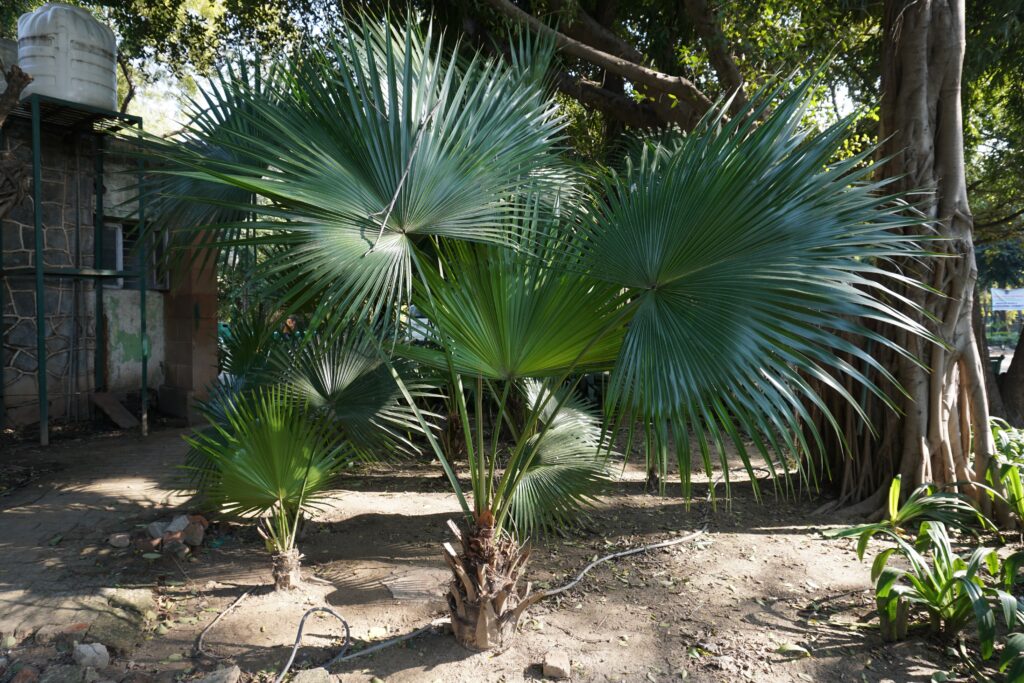
Chinese fan palms thrive indoors and outdoors.
©Vipul1989/Shutterstock.com
The Chinese Fan Palm is a versatile palm plant. They’re great both as outdoor palms and as indoor palm plants. The plant is a perennial that grows up to between 10 and 30 feet in height, typically, and lives for about 40 years. Of course, keeping the tree indoors will change its height, as the pot in which it grows will stunt the plant’s growth. They need to have full to partial sun, meaning they do need to be kept in spaces with lots of natural light and grow lights, on darker days. They’re not terribly sensitive to light, moisture, or temperature needs, so they’re great beginning palm plants for indoor growers.
Areca Palm (Dypsis lutescens)

A bunch of orange-red fruits growing from a mature areca palm.
©iStock.com/chaikom
There are at least two varieties of Lutescens palms known as Areca palms – the Dypsis lutescens and the Chrysalidocarpus lutescens. Both belong to the same family and most gardeners use them interchangeably. They have similar care needs so the issues are insignificant with doing so. The Areca palm, golden palm, bamboo palm (not to be confused with Chamaedorea seifrizii, the “true” bamboo palm”) are all names for these varieties of indoor palm plants.
The Areca palm is one of the easiest varieties to grow as an indoor plant, thanks to its tolerance of low light. This means that though it needs light, it doesn’t have to have precise settings or grow lights to thrive indoors. The tree produces large feathery fronds that grow either yellow-green or light-green leaves. They need moderate water, fertile soil, and monthly fertilization to keep them fresh and lush indoors. They grow between 6 and 10 feet tall as potted palms and require partial sun. Make sure they have well-draining pots.
Majesty Palm (Ravenea rivularis)
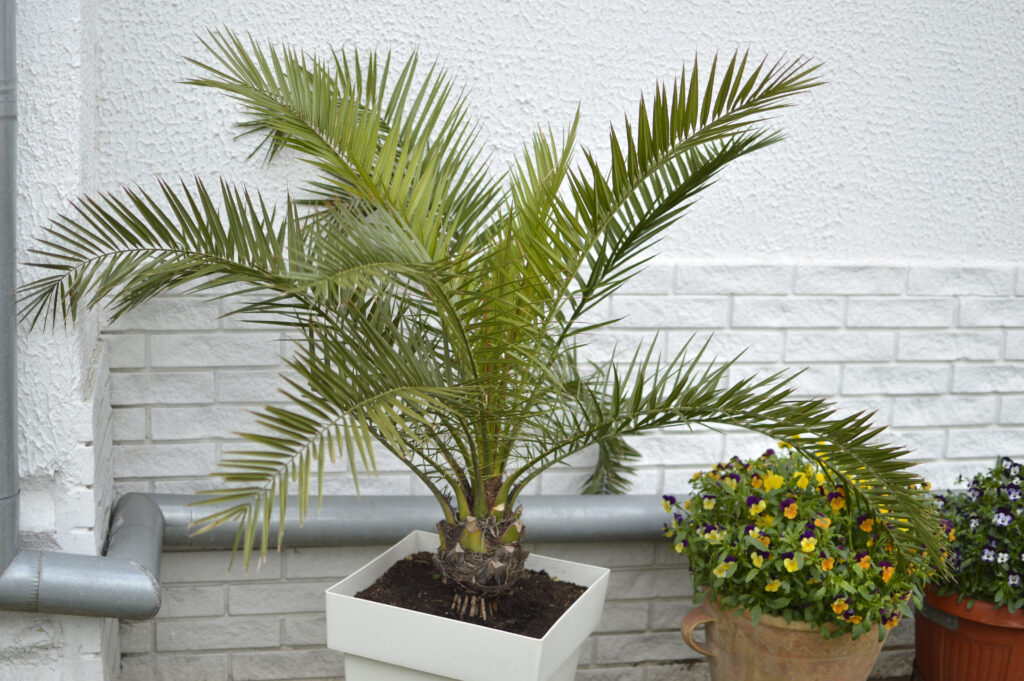
Majesty palms thrive as both indoor and outdoor palms and originate in Madagascar.
©iStock.com/Jana Milin
The Majesty Palm is a gorgeous, tall palm that reaches between 10 and 100 feet in height. That’s a huge range, of course, but the shorter end is what you’ll wind up with indoors as a potted palm. The tree originates in Madagascar in Africa. They need partial sun to thrive and should be watered when the top inch or soil becomes dry. The tree is a bit tougher than some of the other varieties, because they have specific requirements that must be met, so they are recommended primarily for intermediate and advanced indoor gardeners only.
Cascade Palm (Chamaedorea cataractarum)
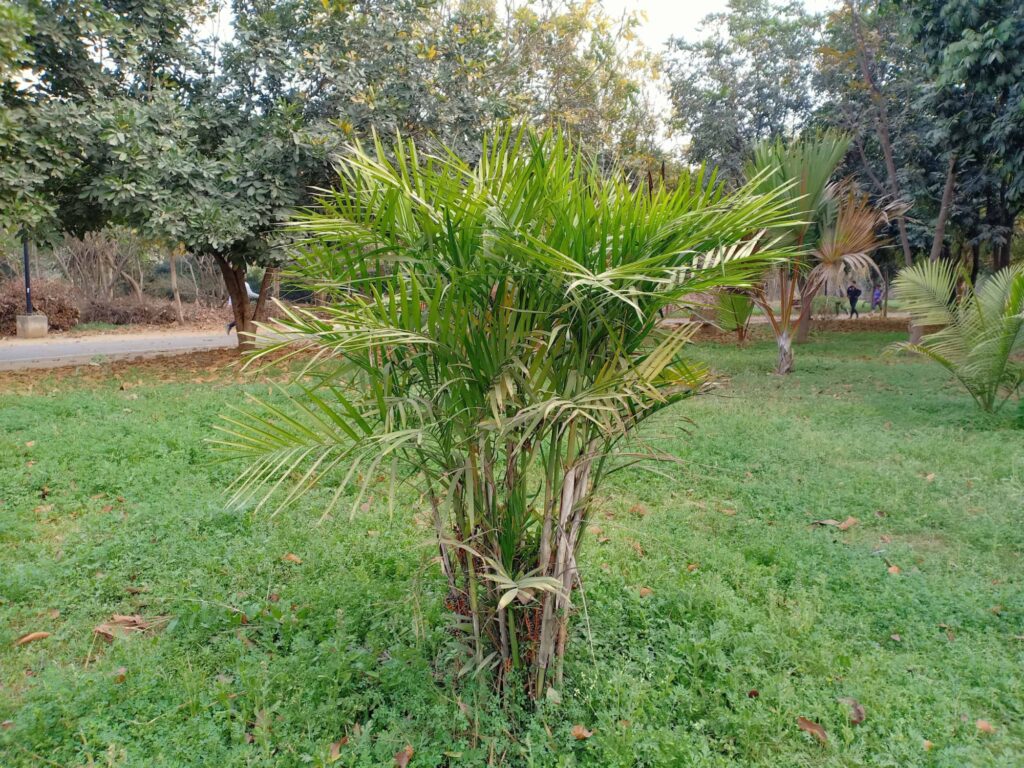
The Cascade palm is on the smaller side, particularly as an indoor palm plant.
©Vipul1989/Shutterstock.com
The gorgeous perennial Cascade palm grows between 3 and 6 feet tall as a potted indoor palm. Cascade palms require partial to indirect light, too, making them one of the best indoor palm plants around. They grow a cluster of stems and grow beautiful, thick leaves in clusters along the stems. Place them in bright environments, out of direct sunlight. Water them once weekly and fertilize them twice annually. Natively, these palms grow in wet lowlands and near rivers and streams, so they also do well with some misting of the leaves.
Ivory Cane Palm (Pinanga coronate)
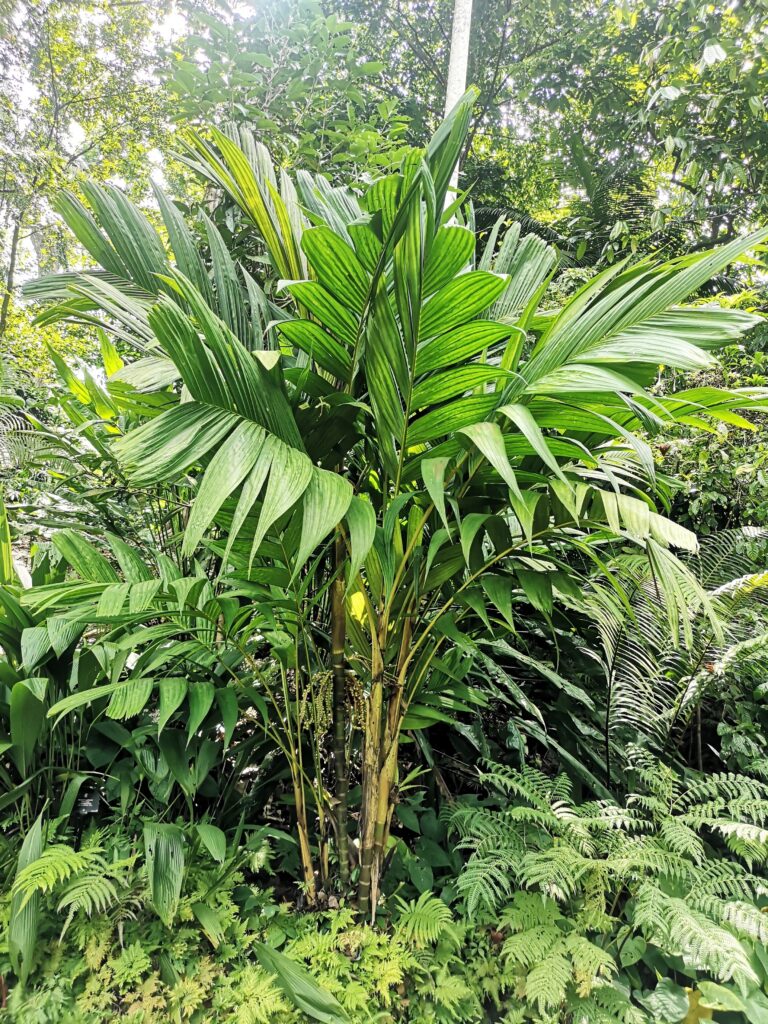
Ivory cane palms have wide, soft leaves and grow in clusters.
©Cheng Wei/Shutterstock.com
Thriving in the shade, the Ivory Cane Palm is an excellent plant for growing indoors. It reaches up to 12 feet tall, though as a potted palm, more commonly 4 to 10 feet, depending on the pot they’re grown in. Ivory Cane palms need partial sun to shade and grow clusters of white or ivory stems that turn green as the tree matures. They produce small pink flowers that turn red and then become purple berries. They can be bonsaied as well.
Kentia Palm (Howea forsteriana)
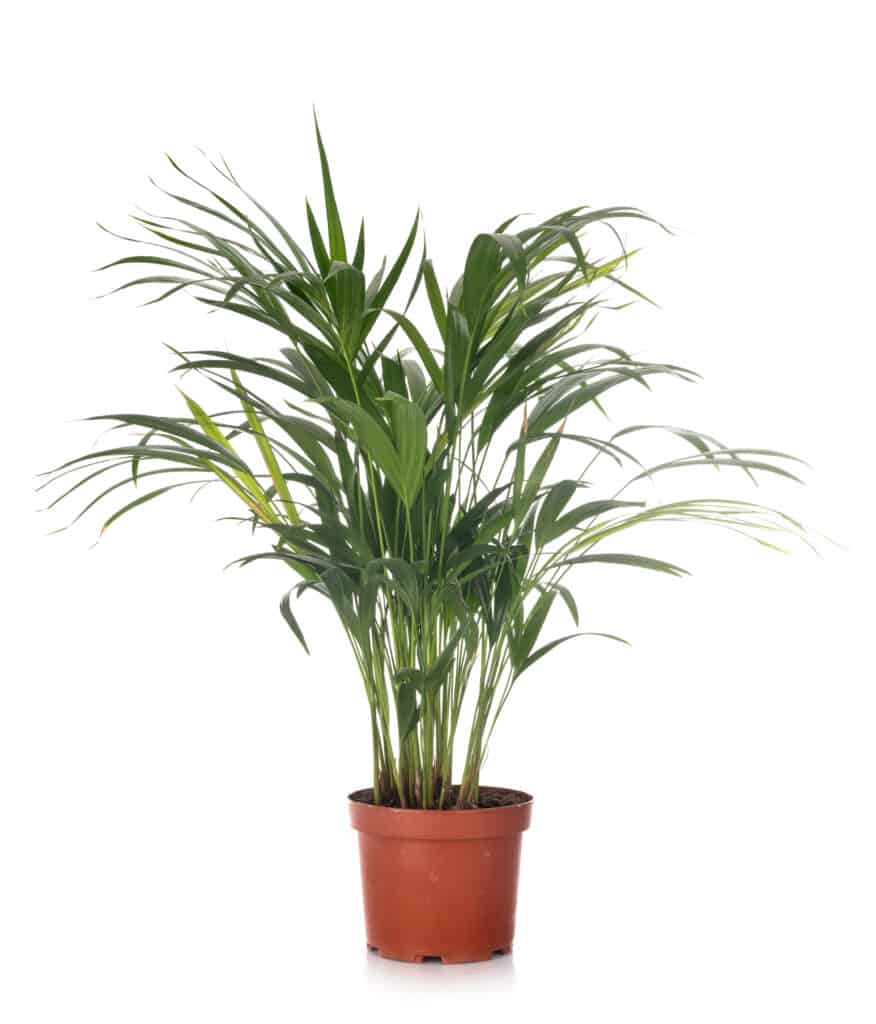
Kentia palms look amazing in pots.
©cynoclub/Shutterstock.com
Growing between 3 and 12 feet, depending on care, location, and pot size, the Kentia Palms are an excellent choice for indoor palm plants. They have attractive ringed trunks and feathery fronds, and develop fruit when the plant is mature. They thrive in low light and shade, especially as young plants. This makes them a great indoor plant for beginning palm growers.
Parlor Palm (Chamaedorea elegans)
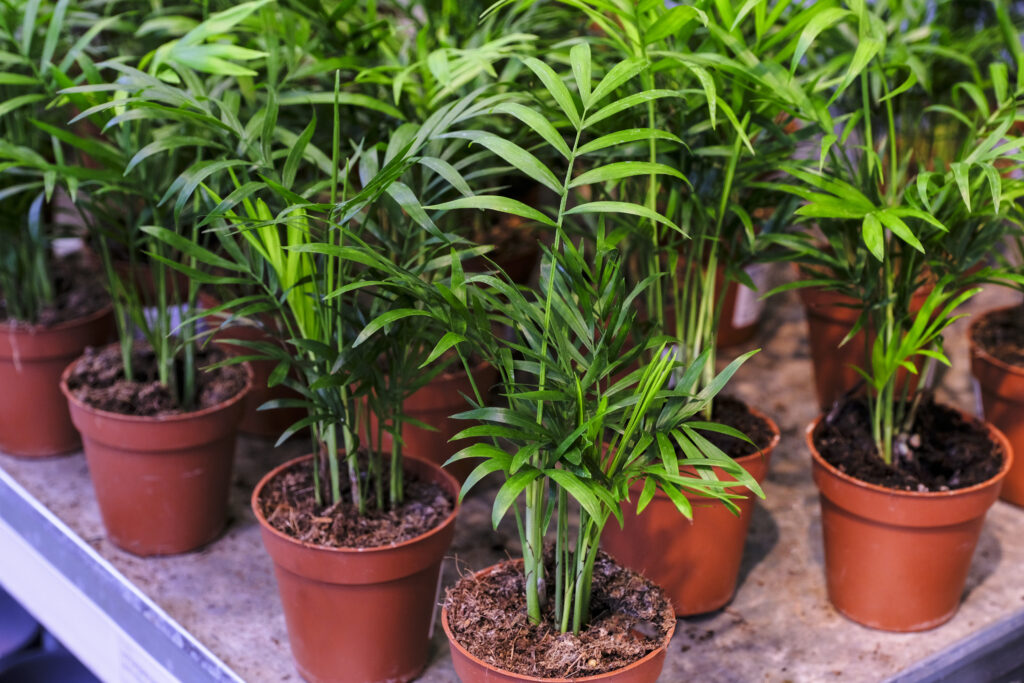
They are often grown in terra cotta or clay pots.
©iStock.com/Olga Ostapenko
The slow-growing Parlor Palm is a beautiful plant that thrives in bright but indirect light. They grow in clumps as shrubs, with light green leaves and don’t require any particular special care. They actually are frequently grown as potted plants in smaller sizes, as well, and may be bonsaied. The only major thing they have issues with in the soil is salt or sodium and they are sensitive to over-watering. They grow to between 1 and 8 feet as a potted plant and though they can’t handle too much water, they should be kept in moist soil. A moisture meter is a great way to make sure they have what they need.
Ponytail Palm (Beaucarnea recurvata)

The lovely ponytail palm may be turned into a bonsai.
©Bilalstock/Shutterstock.com
The Ponytail Palm looks a bit like a shock of hair coming off the top of someone’s head in a wild, unkempt ponytail, thus earning its nickname. Technically, the plant isn’t an actual palm, but rather part of the asparagus family, but it looks and acts like a palm tree. They need sandy soil and prefer indirect light, they’re fairly drought resistant (in summer, they only need to be watered every other week), and they thrive in containers. They’re an exceptionally attractive and easy to grow plant as a potted plant and can even be bonsaied.
Lady Palm (Rhapsis Excelsa)
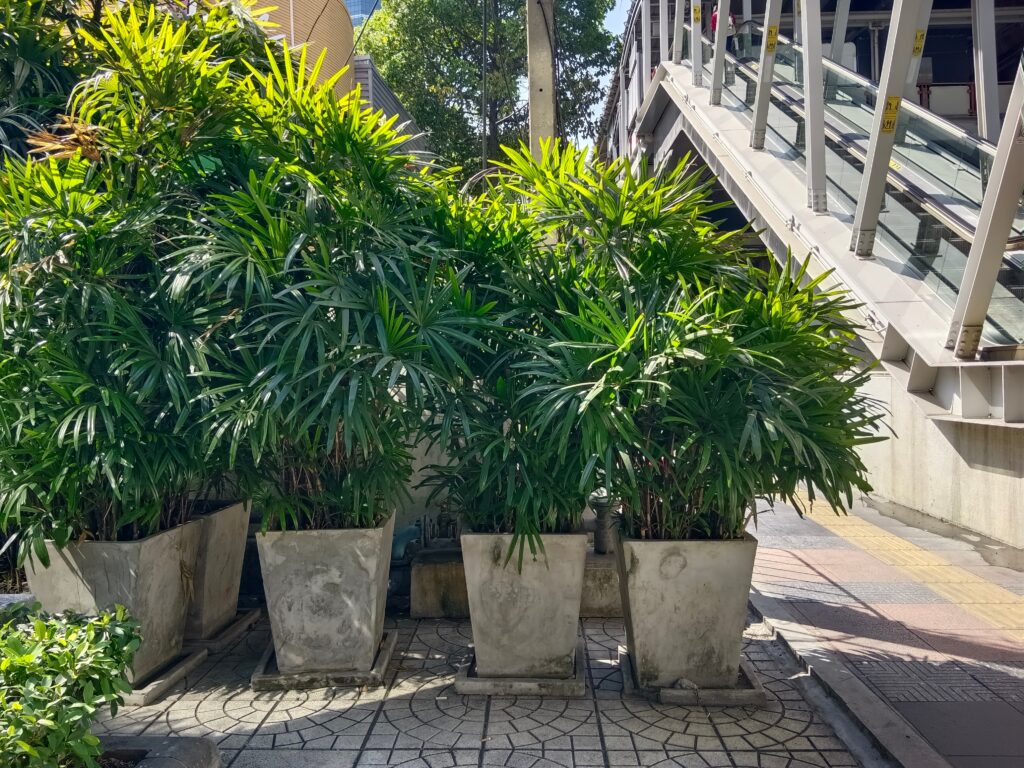
A group of potted Rhapis excelsa or lady palm trees sitting outside in the sunlight. They do excellently as indoor and outdoor potted palms.
©porjai kittawornrat/Shutterstock.com
The Lady Palm is a larger variety of palm that is grown indoors. The tree typically grows between 6 and 15 feet and prefers to dry out so that the soil is about 50% dry before its next watering. The palm prefers partial sun to shade, making it an excellent choice for homes with less than stellar natural lighting for plants. The plant itself grows in clumps of compact stalks that rarely need trimming and the plant, overall, is pretty easy to care for. They love being near windows, as long as they don’t receive direct light. They should be watered when the soil is dry and misted to help keep the humidity for them up, especially if you notice the tips of the fronds start to turn brown.
Sago Palm (Cycas revoluta)
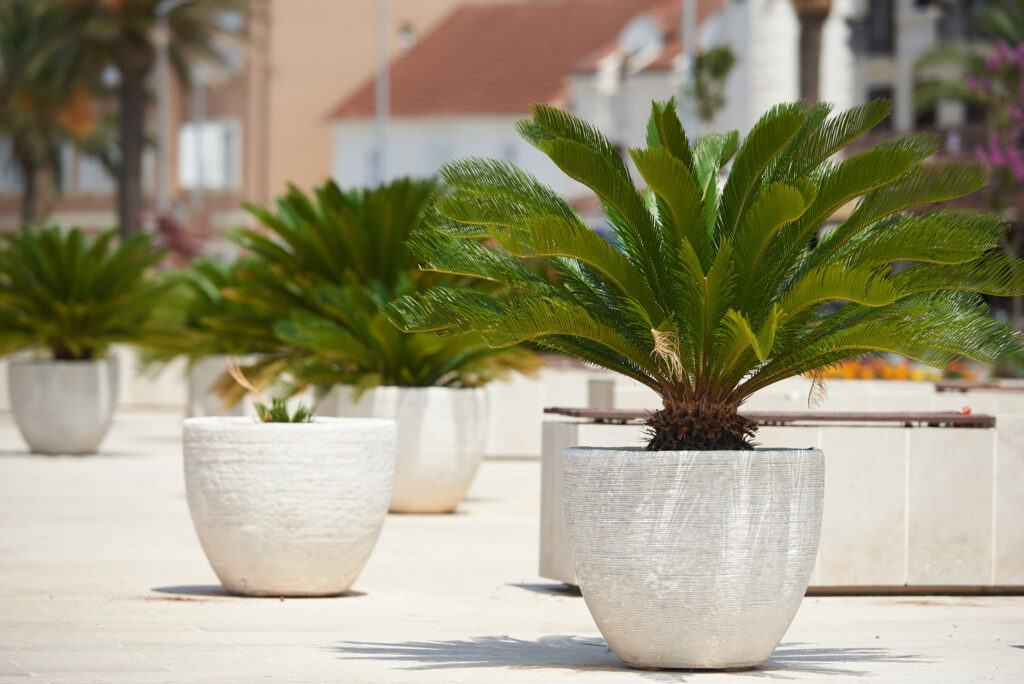
Sago palms are often used ornamentally.
©iStock.com/Pridannikov
Technically, the Sago Palm isn’t a palm but rather a cycad, which looks very similar and behaviors like palm trees. They’re a cold hardy plant that thrives both indoors and outdoors and remain one of the most popular options for home landscaping and interior trees. The plant grows light green, stiff fronds and has a shaggy trunk. They’re slow growing and need moderately moist soil and bright indirect light or full sun, though they do tolerate some shade. The plant will grow to between 3 and 10 feet, depending on care and the size of the pot. It should be noted that Sago palms are toxic to humans and pets, so its placement is critical.
Yucca Palm (Yucca elephantipes)
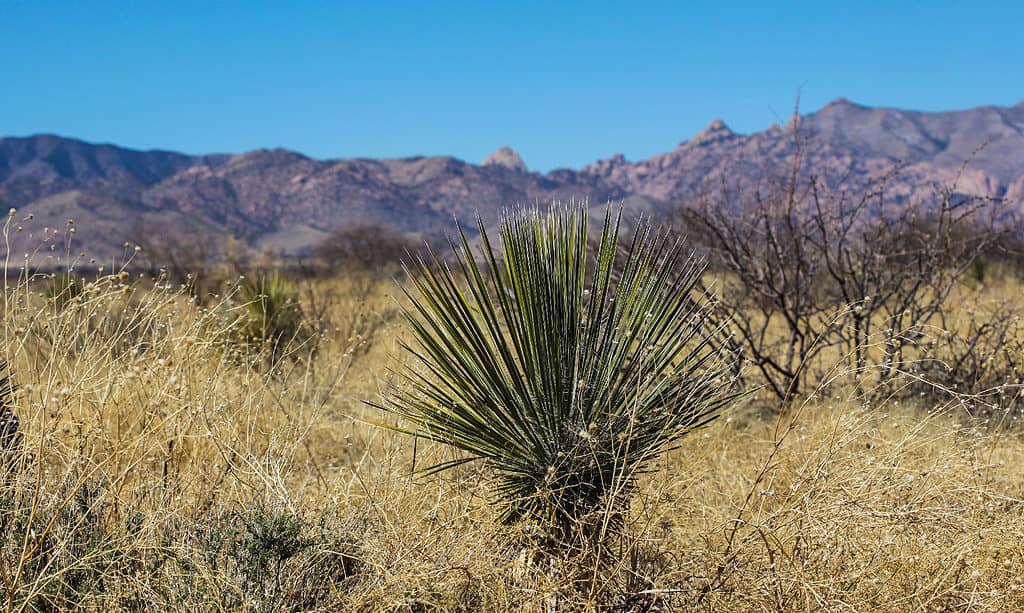
Yucca palms come in 40 different varieties. Be sure to choose the one that isn’t sword-like!
©Ingrid Curry/Shutterstock.com
Yucca palms come in 40 different varieties, so their exact care, size and details are a little harder to pin down without an extensive study. Generally, though, it can be noted that they do best if their soil gets dry between waterings, they thrive in bright, indirect light or partial shade, and most (if not all) varieties remain small enough in pots to be kept as indoor plants. If they don’t receive enough of that indirect light, they will have thin growth. Most folks aim for about 10 to 12 hours of bright environments to keep them thriving. They prefer loose soil that’s properly draining, with waterings only every couple of weeks. Specifically, the Yucca elephantipes is recommended as an indoor variety because their fronds are pointed but won’t slice you as you pass, unlike some of the other varieties.
Banana Palm (Musa oriana)
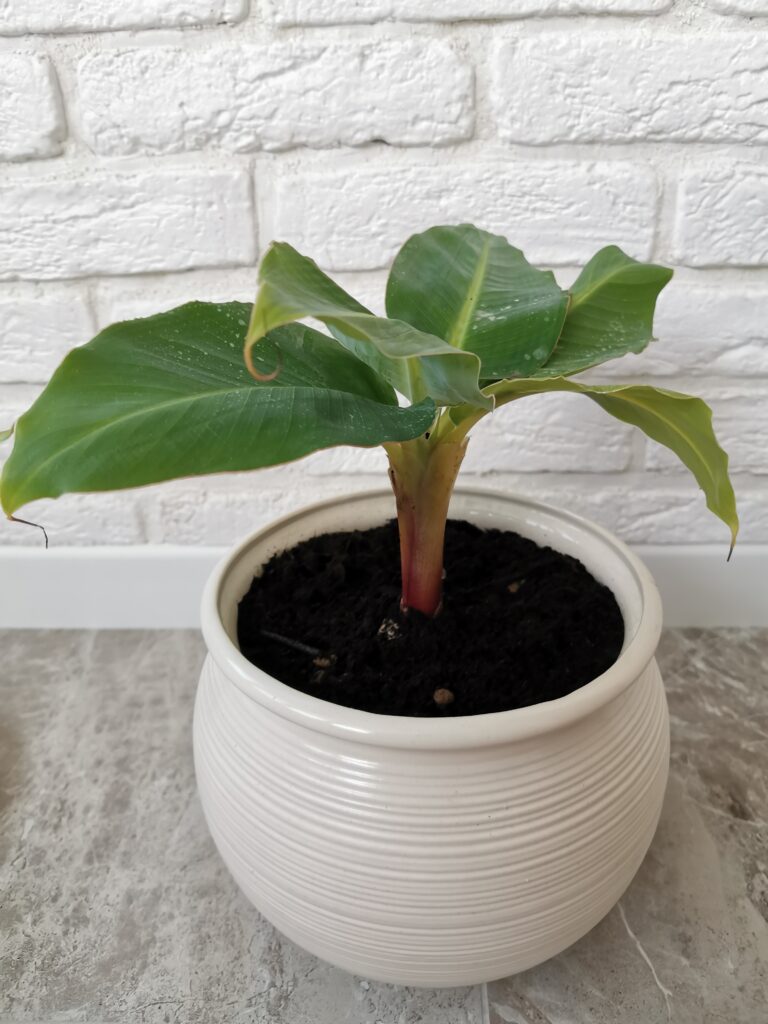
Yes – the banana palm is the one you’re thinking of – a banana tree.
©OlgaXelga/Shutterstock.com
Banana Palms love bright, diffused light. They grow up to be about 6 feet in height, when potted, and are fairly easy to care for. Banana Palms do need about 12 hours of diffused light daily, and regular waterings, so they’re not quite as easy to care for as some of the arid terrain palms like the Yucca. They want compost, nutrient-rich soil, but otherwise are pretty basic in their needs. The plants are actually hard to kill but thrive when properly cared for.
Dwarf Bamboo Palm (Chamaedorea radicalis)
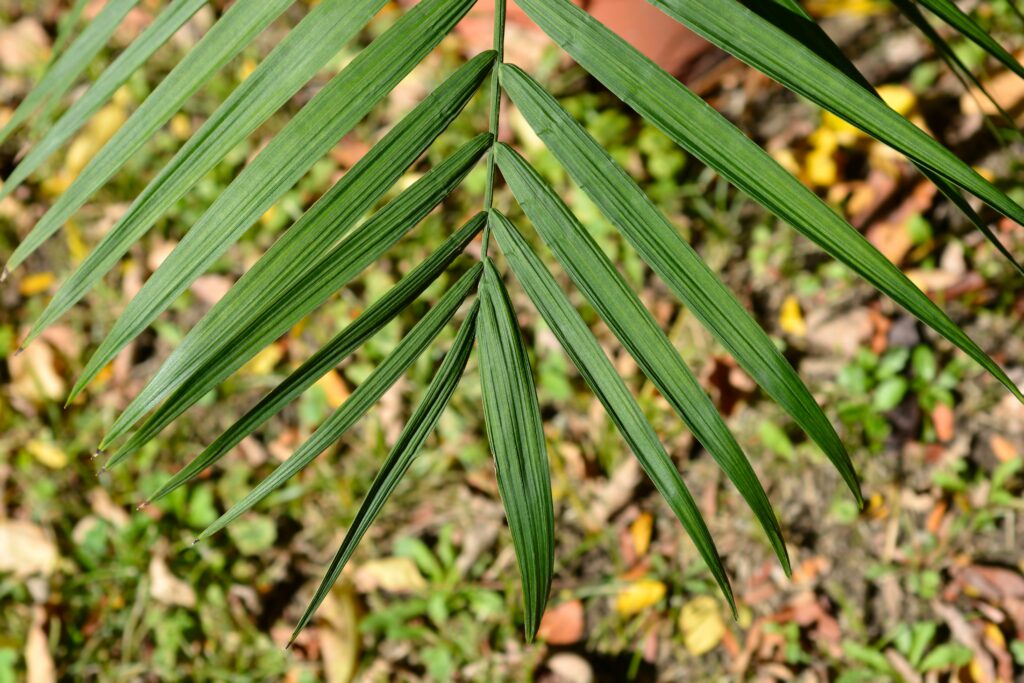
The dwarf bamboo palm has softer leaves than many varieties of palms.
©Nahhana/Shutterstock.com
The Dwarf Bamboo Palm is a bit trickier for new palm growers, as they have heavy moisture demands during the growing months. They grow to be between 2 and 10 feet in height and thrive in anything from full sun to full shade. Many folks grow them indoors because of this and learn to deal with the watering demands because they’re such lovely plants. They develop dark, thick leaves as a container plant.
Pygmy Date Palm (Phoenix roebelenii)

The Pygmy Date Palm is frequently used in landscaping but thrives indoors as well.
©alybaba/Shutterstock.com
Phoenix roebelenii are a higher-humidity palm than some of the other varieties that thrive indoors. They tend to dry out if they get too dry, so many folks mist them to keep them healthy and happy. The plant may grow between 10 inches and 6.5 feet in pots, though lean towards the shorter end when kept indoors. They thrive in bright, indirect sun and need proper drainage. They produce edible purple fruits on the female plants.
Sunset Palm (Areca vestiaria)

The Sunset Palm has red in the stalks and leaves as the plant matures.
©MAHATHIR MOHD YASIN/Shutterstock.com
Sunset palms are a much smaller variety of palm tree that grows, as a potted plant, to just shy of 3 feet. They require partial shade to shade and like to dry out a little bit between waterings. All of this makes the tree an excellent choice for beginners. One thing that sets it apart, though, is the red leaves the palm tree grows. They grow these red leaves that eventually turn green as they mature. They are fairly easy to care for but they do need consistent moisture without over-watering. Using a moisture meter is highly recommended to keep them healthy and flourishing. You may also want to mist the plant, as it is naturally inclined toward higher humidity and most homes don’t usually have even moisture in them save in bathrooms.
Red Feather Palm (Chambeyronia macrocarpa)
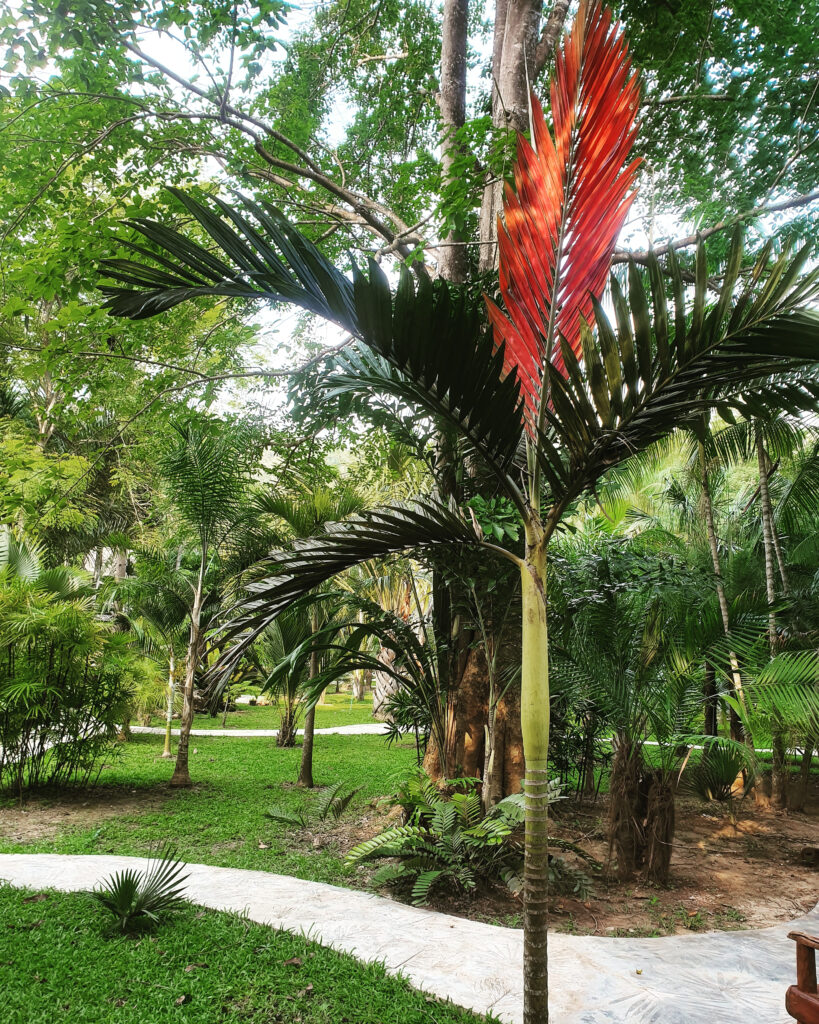
Vivid red leaves grow in like this one, adding a truly unique look to the red feather palm.
©ChalermchartSoo/Shutterstock.com
Similar to the Sunset Palm, the Red Feather Palm also grows bright red leaves, which turn green as they mature. The plant is much larger, though, growing up to 25 feet. They love sun to partial sun and should dry slightly between waterings. The plant is also known as the Flamethrower Palm, thanks to the cacophony of red leaves it grows in large sizer, between 10 and 12 inches in length. They also produce small purple fruits that many birds enjoy eating. They should be misted to keep the moisture high and watered often. Fertilize twice annually for best results.
Lipstick Palm (Cyrtostachys renda)

The lovely lipstick palm develops red and green stems.
©Michaelnero/Shutterstock.com
A third palm to produce red coloring is the Lipstick Palm. This tree, however, has red stems, not leaves, which mature into green shades as the plant grows. The plant may reach up to 35 feet, though in a pot will be much, much smaller. Lipstick Palms need sun to partial sun and produce first white flowers and then black fruit. They love humidity, so keep the plant moist through misting and regular waterings, but avoid over-watering as this may cause root rot. Fertilize them twice a year.
Fishtail Palm (Caryota mitis)
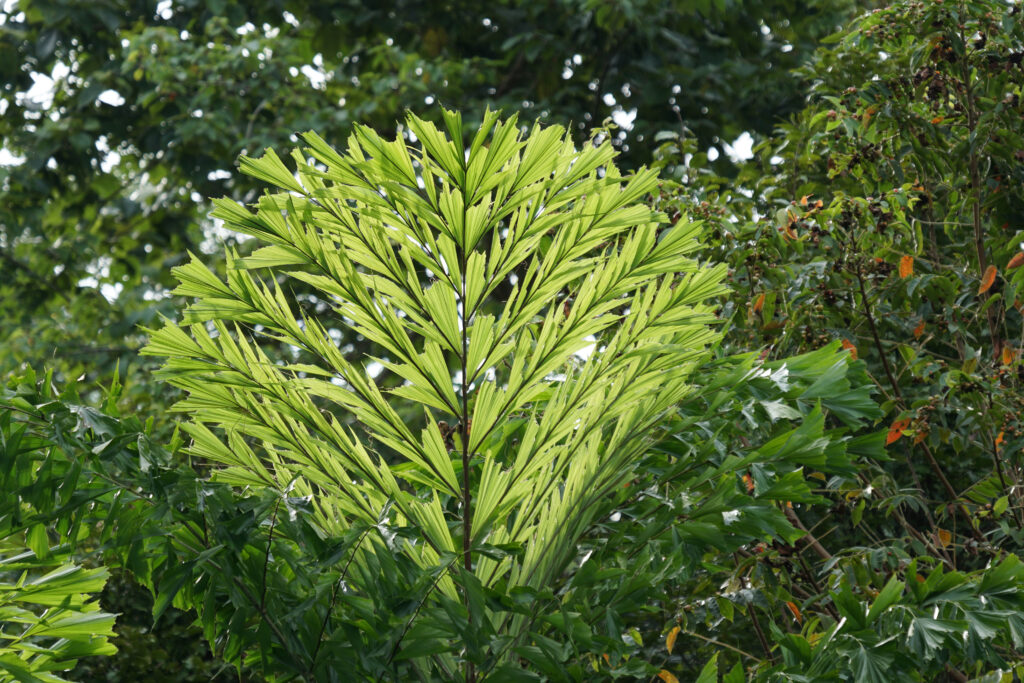
The unique Fishtail palm grows leaves that look like, well, fishtails.
©Doikanoy/Shutterstock.com
The Fishtail Palm earns its name from the shape of its leaves that look a bit like fishtails. They’re not the easiest palms to grow, particularly indoors, but those who are ready for the task can do it. Fishtail palms need lots of moisture-related attention, which can be tricky. They need to be misted often and watered fairly frequently, avoiding over-watering. The plant needs partial to full shade, which is part of why they are often chosen as indoor plants, and may grow up to 20 feet tall, though rarely do so as potted palms.
Ivory Crownshaft Palm (Pinanga dicksonii)
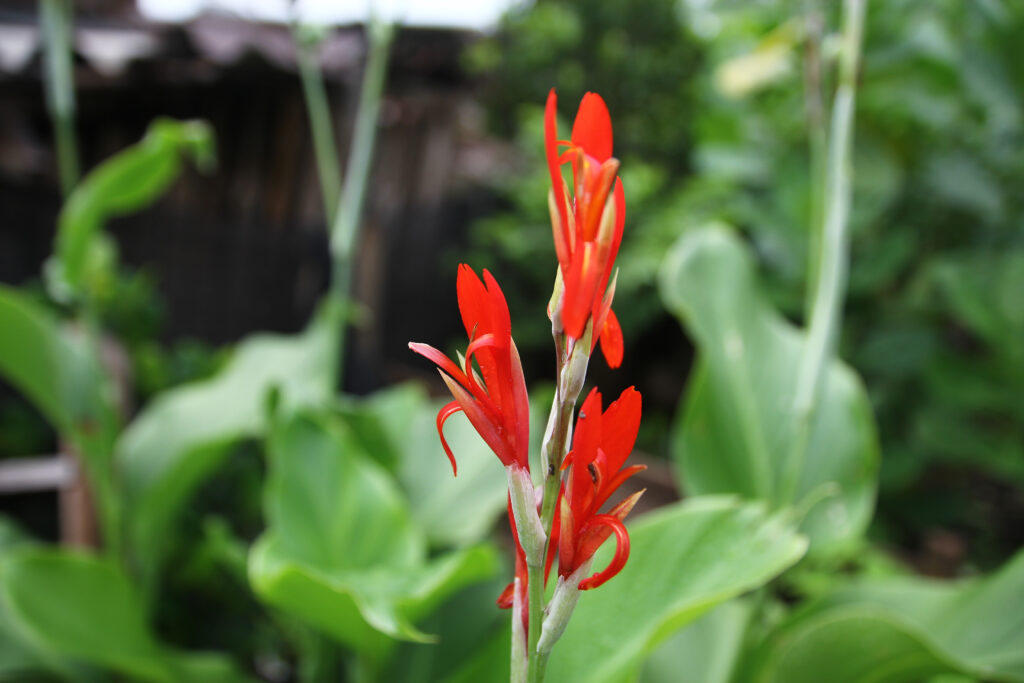
The vivid red flower of the Ivory Crownshaft palm helps attract pollinators and humans alike to the tree.
©Eddie Photo/Shutterstock.com
Preferring indirect light and moist soil, the Ivory Crownshaft Palm is an intermediate indoor plant that most folks can handle growing, as long as they’re able to keep the needed regular watering schedule. They have a yellow to white crown of leaves and the trees themselves usually grow between 10 and 30 feet tall (the shorter end more common for indoor plants). The Ivory Crownshaft has a single trunk. They require a lot of indirect light to thrive so should be given grow lights if your window situation isn’t ideal for indoor plants. They produce vivid red flowers that draw many folks to keep them as indoor plants.
The photo featured at the top of this post is © iStock.com/ablokhin
Thank you for reading! Have some feedback for us? Contact the AZ Animals editorial team.






